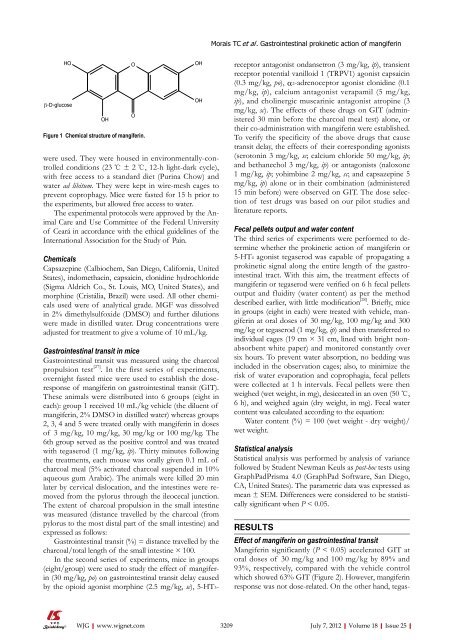Ghrelin's second life - World Journal of Gastroenterology
Ghrelin's second life - World Journal of Gastroenterology
Ghrelin's second life - World Journal of Gastroenterology
You also want an ePaper? Increase the reach of your titles
YUMPU automatically turns print PDFs into web optimized ePapers that Google loves.
HO<br />
b-D-glucose<br />
OH<br />
Figure 1 Chemical structure <strong>of</strong> mangiferin.<br />
were used. They were housed in environmentally-controlled<br />
conditions (23 ℃ ± 2 ℃, 12-h light-dark cycle),<br />
with free access to a standard diet (Purina Chow) and<br />
water ad libitum. They were kept in wire-mesh cages to<br />
prevent coprophagy. Mice were fasted for 15 h prior to<br />
the experiments, but allowed free access to water.<br />
The experimental protocols were approved by the Animal<br />
Care and Use Committee <strong>of</strong> the Federal University<br />
<strong>of</strong> Ceará in accordance with the ethical guidelines <strong>of</strong> the<br />
International Association for the Study <strong>of</strong> Pain.<br />
Chemicals<br />
Capsazepine (Calbiochem, San Diego, California, United<br />
States), indomethacin, capsaicin, clonidine hydrochloride<br />
(Sigma Aldrich Co., St. Louis, MO, United States), and<br />
morphine (Cristália, Brazil) were used. All other chemicals<br />
used were <strong>of</strong> analytical grade. MGF was dissolved<br />
in 2% dimethylsulfoxide (DMSO) and further dilutions<br />
were made in distilled water. Drug concentrations were<br />
adjusted for treatment to give a volume <strong>of</strong> 10 mL/kg.<br />
Gastrointestinal transit in mice<br />
Gastrointestinal transit was measured using the charcoal<br />
propulsion test [27] . In the first series <strong>of</strong> experiments,<br />
overnight fasted mice were used to establish the doseresponse<br />
<strong>of</strong> mangiferin on gastrointestinal transit (GIT).<br />
These animals were distributed into 6 groups (eight in<br />
each): group 1 received 10 mL/kg vehicle (the diluent <strong>of</strong><br />
mangiferin, 2% DMSO in distilled water) whereas groups<br />
2, 3, 4 and 5 were treated orally with mangiferin in doses<br />
<strong>of</strong> 3 mg/kg, 10 mg/kg, 30 mg/kg or 100 mg/kg. The<br />
6th group served as the positive control and was treated<br />
with tegaserod (1 mg/kg, ip). Thirty minutes following<br />
the treatments, each mouse was orally given 0.1 mL <strong>of</strong><br />
charcoal meal (5% activated charcoal suspended in 10%<br />
aqueous gum Arabic). The animals were killed 20 min<br />
later by cervical dislocation, and the intestines were removed<br />
from the pylorus through the ileocecal junction.<br />
The extent <strong>of</strong> charcoal propulsion in the small intestine<br />
was measured (distance travelled by the charcoal (from<br />
pylorus to the most distal part <strong>of</strong> the small intestine) and<br />
expressed as follows:<br />
Gastrointestinal transit (%) = distance travelled by the<br />
charcoal/total length <strong>of</strong> the small intestine × 100.<br />
In the <strong>second</strong> series <strong>of</strong> experiments, mice in groups<br />
(eight/group) were used to study the effect <strong>of</strong> mangiferin<br />
(30 mg/kg, po) on gastrointestinal transit delay caused<br />
by the opioid agonist morphine (2.5 mg/kg, sc), 5-HT3-<br />
O<br />
O<br />
WJG|www.wjgnet.com<br />
OH<br />
OH<br />
Morais TC et al . Gastrointestinal prokinetic action <strong>of</strong> mangiferin<br />
receptor antagonist ondansetron (3 mg/kg, ip), transient<br />
receptor potential vanilloid 1 (TRPV1) agonist capsaicin<br />
(0.3 mg/kg, po), α2-adrenoceptor agonist clonidine (0.1<br />
mg/kg, ip), calcium antagonist verapamil (5 mg/kg,<br />
ip), and cholinergic muscarinic antagonist atropine (3<br />
mg/kg, sc). The effects <strong>of</strong> these drugs on GIT (administered<br />
30 min before the charcoal meal test) alone, or<br />
their co-administration with mangiferin were established.<br />
To verify the specificity <strong>of</strong> the above drugs that cause<br />
transit delay, the effects <strong>of</strong> their corresponding agonists<br />
(serotonin 3 mg/kg, sc; calcium chloride 50 mg/kg, ip;<br />
and bethanechol 3 mg/kg, ip) or antagonists (naloxone<br />
1 mg/kg, ip; yohimbine 2 mg/kg, sc; and capsazepine 5<br />
mg/kg, ip) alone or in their combination (administered<br />
15 min before) were observed on GIT. The dose selection<br />
<strong>of</strong> test drugs was based on our pilot studies and<br />
literature reports.<br />
Fecal pellets output and water content<br />
The third series <strong>of</strong> experiments were performed to determine<br />
whether the prokinetic action <strong>of</strong> mangiferin or<br />
5-HT4 agonist tegaserod was capable <strong>of</strong> propagating a<br />
prokinetic signal along the entire length <strong>of</strong> the gastrointestinal<br />
tract. With this aim, the treatment effects <strong>of</strong><br />
mangiferin or tegaserod were verified on 6 h fecal pellets<br />
output and fluidity (water content) as per the method<br />
described earlier, with little modification [28] . Briefly, mice<br />
in groups (eight in each) were treated with vehicle, mangiferin<br />
at oral doses <strong>of</strong> 30 mg/kg, 100 mg/kg and 300<br />
mg/kg or tegaserod (1 mg/kg, ip) and then transferred to<br />
individual cages (19 cm × 31 cm, lined with bright nonabsorbent<br />
white paper) and monitored constantly over<br />
six hours. To prevent water absorption, no bedding was<br />
included in the observation cages; also, to minimize the<br />
risk <strong>of</strong> water evaporation and coprophagia, fecal pellets<br />
were collected at 1 h intervals. Fecal pellets were then<br />
weighed (wet weight, in mg), desiccated in an oven (50 ℃,<br />
6 h), and weighed again (dry weight, in mg). Fecal water<br />
content was calculated according to the equation:<br />
Water content (%) = 100 (wet weight - dry weight)/<br />
wet weight.<br />
Statistical analysis<br />
Statistical analysis was performed by analysis <strong>of</strong> variance<br />
followed by Student Newman Keuls as post-hoc tests using<br />
GraphPadPrisma 4.0 (GraphPad S<strong>of</strong>tware, San Diego,<br />
CA, United States). The parametric data was expressed as<br />
mean ± SEM. Differences were considered to be statistically<br />
significant when P < 0.05.<br />
RESULTS<br />
Effect <strong>of</strong> mangiferin on gastrointestinal transit<br />
Mangiferin significantly (P < 0.05) accelerated GIT at<br />
oral doses <strong>of</strong> 30 mg/kg and 100 mg/kg by 89% and<br />
93%, respectively, compared with the vehicle control<br />
which showed 63% GIT (Figure 2). However, mangiferin<br />
response was not dose-related. On the other hand, tegas-<br />
3209 July 7, 2012|Volume 18|Issue 25|

















